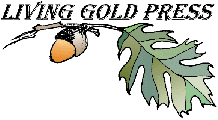
Questions?
Email us at: JandK@LivingGoldPress.com
 HOME
HOME
 |
Email us at: JandK@LivingGoldPress.com
|
|
There’s Gold in Them Thar Hills!Alas, it seems the miners of 160 years ago missed out on most of it. The Golden State holds so much more amber wealth and beauty than just the lustrous mineral. Golden hues deck our world liberally, often with ephemeral but recurring glory and ache. They join with pinks and grays to brush our skies at dawn and dusk. In spring they gleam from the soft petals of poppies and the burry stripes of the bees who visit them, and the sweet honey that those two together produce; in fall, the hills and fields of dried grass, especially under sun after rain, glow goldenrod, and maples and oaks effuse geysers of leaves radiant with mustard and ochre and burnished apricot; blonde cider flows from foothill orchards, and under foothill streams trout flash their brilliance. Gold shines in the eyes of blackbirds and eagles, and in bright braids from sun-dappled rivers and lakes; and this time of year, every year, from the optimistic caps of brown little birds, like something hopeful in the miner’s pan. Golden-crowned sparrows are mostly a camouflage of browns and grays, perfect for hiding in under-brush shadows. But like so much of life, they have their shine, too—just a modest dash of color, for them. Adults wear their golden crowns offset with a circlet of black. Young birds sport a smaller, paler spot of yellow, muted with fine black streaks and bordered with a nondescript earth tone, like last year’s leaves. Some observers note that the pinkish bill of young birds goes gray with age, starting with the upper mandible. These sparrows have been northward throughout the summer months. Denizens of the west, they nested from northern British Columbia up into Alaska, as far as the Arctic Circle, where, tucked among grasses and shrubs in boggy meadows, they wove a dense cup lined with feathers or moose hair, perhaps just above spring snow but most often on the ground. They raised a clutch or two with about four eggs in each. Now both parents and fledglings have flown south, centering their winter range right here in northern California. They can be seen at backyard feeders, although they are generally wilder and scarcer than their racier, more numerous cousins, the white-crowned sparrows. Like many sparrows, golden-crowns have a beautiful voice. In our brushy yards and hillsides they can be heard on sunny winter mornings, singing a clear Oh, dear, me! that manages to be both woebegone and beautiful. Studies on these birds are few, but the sparrows are part of recent measurements of mass bird migrations. Weather radar, with increasing precision, has in the last several years harvested information on not just storm clouds but on clouds of birds. The researchers report spring migrations over the US/Canada border at about 2.6 billion birds. The return trip, coming south in autumn with a new season of surviving fledglings, numbers about 4 billion. Those nesting seasons are immeasurably valuable. They keep the gold recurring in California. |